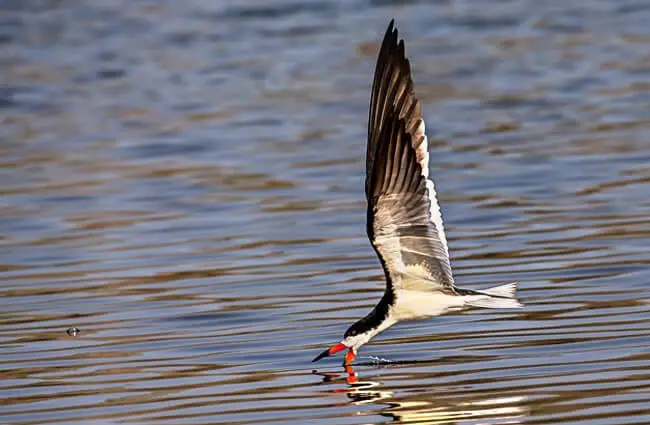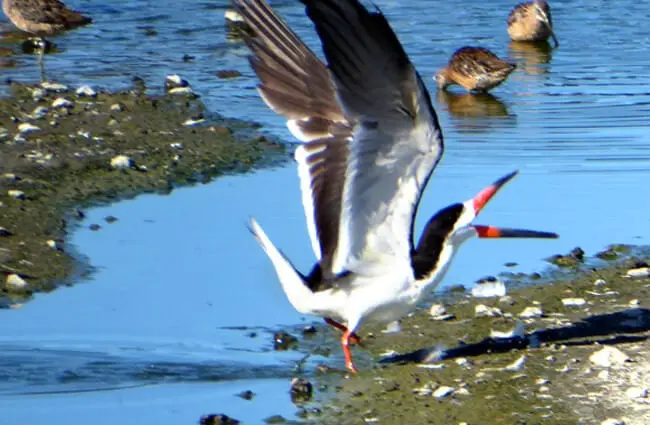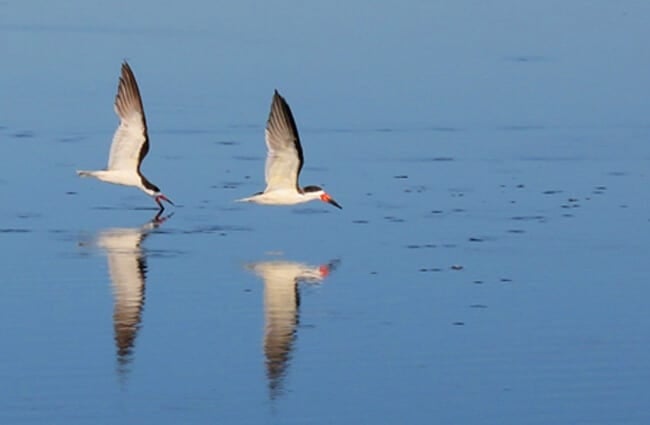The avian world boasts a remarkable diversity of feeding strategies, and among the most specialized and captivating is that of the skimmer. These elegant birds, instantly recognizable by their unique bill shape and distinctive flight style, are true masters of their aquatic niche. This article delves into the fascinating world of skimmers, exploring their biology, behavior, ecological role, and interactions with humans.

What is a Skimmer?
Skimmers, belonging to the family Rynchopidae, are a group of seabirds characterized by a strikingly unique adaptation—a significantly elongated lower mandible that is longer than the upper mandible. This specialized bill is the key to their unusual feeding method. There are two recognized species of skimmer: the Black Skimmer (Rynchops niger) and the Silver Skimmer (Rynchops albicollis). The Black Skimmer is the most widespread and commonly observed species, found across the Atlantic and Gulf coasts of North and South America. The Silver Skimmer is found along the southern coast of Africa and in parts of the Indian Ocean.
Physical Characteristics
Beyond the bill, skimmers are medium‑sized birds, typically ranging from 30 to 40 centimeters in length, with a wingspan that can exceed a meter. They possess sleek, streamlined bodies that provide efficient flight capabilities. Plumage is generally white and black, offering camouflage and potentially aiding in thermoregulation. Their legs are long and dark, perfectly adapted for wading in shallow water.
Habitat and Distribution
Skimmers are largely coastal birds, favoring shallow, sheltered waters such as lagoons, estuaries, salt marshes, and beaches. They require calm conditions to effectively utilize their feeding technique. Black Skimmers breed along the Atlantic and Gulf coasts of North and South America, while Silver Skimmers are found on the southern coast of Africa and the Indian Ocean. Both species prefer sandy or muddy shorelines for nesting.

The Unique Feeding Strategy
The skimmer’s feeding strategy is truly remarkable. Flying low over the water—often just a few feet above the surface—it extends its lower mandible into the water, creating a shallow channel. As the bird glides forward, water rushes along this channel, and small fish, crustaceans, and insects are swept into the gap between the jaws. This method allows skimmers to feed efficiently in calm, well‑lit waters, setting them apart from most other seabirds.
Dietary Habits
While small fish make up the majority of a skimmer’s diet, they are opportunistic feeders and will consume a variety of aquatic invertebrates. Prey composition varies with location and season; during the breeding season, they often target schooling fish to provide the necessary nutrition for their chicks.
Skimmer Reproduction and Life Cycle
Skimmers are colonial nesters that form breeding colonies on sandy or muddy islands and beaches. They lay a clutch of three to seven eggs, typically pale buff or cream colored with dark markings. Both parents incubate the eggs and care for the chicks.

Nesting and Chick Development
Skimmers create shallow scrapes in the sand or mud for their nests, sometimes lining them with grasses or other vegetation. Chicks are precocial, meaning they are relatively mobile and can leave the nest soon after hatching. However, they remain dependent on their parents for food and protection for several weeks. Young skimmers reach sexual maturity after approximately two to three years.
Ecological Role and Interactions
Skimmers play an important role in their ecosystems as predators of small fish and invertebrates. They help regulate prey populations and contribute to the overall health of aquatic habitats. They often forage alongside other seabirds, creating a diverse and dynamic coastal community.
Interactions with Other Species
Skimmers sometimes engage in kleptoparasitism, stealing food from other birds, though this behavior is less common than in some other seabird species. They can also be preyed upon by larger birds of prey, such as falcons and hawks, and their nests are vulnerable to predation by mammals like foxes and raccoons.

Skimmers and Human Interactions
Historically, skimmers were targeted for their feathers, which were used in the millinery trade. However, this practice has largely ceased due to conservation efforts. Today, the primary threats to skimmer populations are habitat loss, disturbance of breeding colonies, and pollution.
Conservation Status
The Black Skimmer is currently listed as Least Concern by the International Union for Conservation of Nature (IUCN). Conservation efforts focus on protecting nesting sites, restoring degraded habitats, and reducing pollution levels.
Spotting Skimmers in the Wild
For birdwatchers and nature enthusiasts, observing skimmers in the wild is a rewarding experience. Look for them in coastal areas with calm, shallow waters. They are most active during the warmer months, when they are breeding and foraging. Be sure to maintain a respectful distance from nesting colonies to avoid disturbing the birds.

Skimmers in Captivity
Skimmers are not commonly kept in captivity, but a few zoos and aquariums may house them for educational purposes. Providing appropriate care requires a large enclosure with access to water for foraging, a sandy or muddy substrate for nesting, and a diet of fresh fish and invertebrates. Maintaining a calm and undisturbed environment is crucial for breeding success.
Fascinating Skimmer Facts
- Skimmers can adjust the angle of their lower mandible to optimize water flow during foraging.
- They are capable of precise aerial maneuvers, allowing them to skim the water surface with remarkable accuracy.
- Skimmer chicks are often fed regurgitated fish by their parents.
- The elongated bill of the skimmer is a classic example of adaptive evolution.
- Skimmers are highly social birds, often foraging and nesting in large colonies.

The skimmer, with its unique morphology and specialized feeding strategy, is a captivating example of the incredible diversity of avian life. Its ecological role, combined with its fascinating behaviors, makes it a truly remarkable bird worthy of our attention and conservation efforts. By understanding and appreciating these elegant creatures, we can ensure their continued survival for generations to come.

![Red Angus Closeup of a beautiful Red Angus cowPhoto by: U.S. Department of Agriculture [pubic domain]https://creativecommons.org/licenses/by/2.0/](https://animals.net/wp-content/uploads/2020/03/Red-Angus-4-238x178.jpg)




![Red Angus Closeup of a beautiful Red Angus cowPhoto by: U.S. Department of Agriculture [pubic domain]https://creativecommons.org/licenses/by/2.0/](https://animals.net/wp-content/uploads/2020/03/Red-Angus-4-100x75.jpg)

